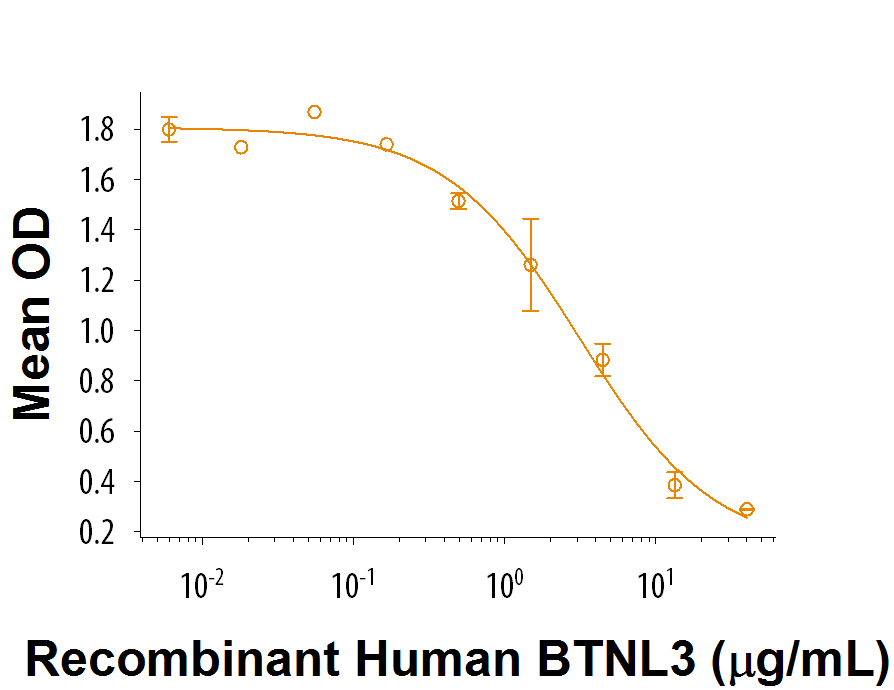Recombinant Human BTNL3 Fc Chimera Protein, CF
View Webinar
Recombinant Human BTNL3 Fc Chimera Protein, CF Summary
Product Specifications
| Human BTNL3 (Gln18-Ser237) Accession # Q6UXE8-1 | IEGRMD | Human IgG1 (Pro100-Lys330) |
| N-terminus | C-terminus |
Analysis
Disulfide-linked homodimer
Product Datasheets
Carrier Free
CF stands for Carrier Free (CF). We typically add Bovine Serum Albumin (BSA) as a carrier protein to our recombinant proteins. Adding a carrier protein enhances protein stability, increases shelf-life, and allows the recombinant protein to be stored at a more dilute concentration. The carrier free version does not contain BSA.
In general, we advise purchasing the recombinant protein with BSA for use in cell or tissue culture, or as an ELISA standard. In contrast, the carrier free protein is recommended for applications, in which the presence of BSA could interfere.
9658-BT
| Formulation | Lyophilized from a 0.2 μm filtered solution in PBS. |
| Reconstitution | Reconstitute at 200 μg/mL in PBS. |
| Shipping | The product is shipped at ambient temperature. Upon receipt, store it immediately at the temperature recommended below. |
| Stability & Storage: | Use a manual defrost freezer and avoid repeated freeze-thaw cycles.
|
Scientific Data
 View Larger
View Larger
Recombinant Human BTNL3 Fc Chimera (Catalog # 9658-BT) inhibits IFN‑gamma secretion by human peripheral blood mononuclear cells in the presence of anti-CD3 antibody. The ED50 for this effect is 1-6 μg/mL.
Reconstitution Calculator
Background: BTNL3
Butyrophilin-like 3 (BTNL3) is a member of the BTN/MOG Ig-superfamily which is coded by the BTNL3 gene, also known as COLF4100 (1). BTNL3 is a 466 amino acid (aa) type I transmembrane protein that contains a 220 aa extracellular domain (ECD), a 21 aa helical transmembrane domain, and a 208 aa cytoplasmic domain. The ECD features both an IgV and IgC domain, which is commonplace in BTN/BTNL proteins, but the IgC domain is relatively weak (2-5). The ECD of human BTNL3 shares only 37% and 34% aa sequence identity with mouse (referred to as BTNL1) and rat, respectively. Human BTNL3 mRNA has been identified in many tissues including small intestine, colon, liver, lung, bone marrow and spleen tissue, and it is highly expressed in neutrophils (2-6). BTNL3 expression has also been found to be down-regulated in colon cancer tumors (7). The specific function of BTNL3, however, has yet to be fully elucidated. R&D in house data indicate that BTNL3 protein inhibits the secretion of IFN-gamma from anti-CD3 activated human T cells.
- Shibui, A. et al. (1999) J. Hum. Genet. 44:249.
- Arnett, H.A. et al. (2014) Nat Rev Immunol. 14:5596.
- Arnett, H.A. et al. (2009) Cytokine 46:370.
- Abeler-Dorner, L. et al. (2012) Trends Immunol. 33:34.
- Rhodes, D. et al. (2016) Annu. Rev. Immunol. 34:151.
- Guo, Y and Wang, AY (2015) Front. Immunol. 6:421.
- Lebrero-Fernandez, C. et al. (2016) Immun. Inflammation Dis. 4:191.
FAQs
No product specific FAQs exist for this product, however you may
View all Proteins and Enzyme FAQsReviews for Recombinant Human BTNL3 Fc Chimera Protein, CF
There are currently no reviews for this product. Be the first to review Recombinant Human BTNL3 Fc Chimera Protein, CF and earn rewards!
Have you used Recombinant Human BTNL3 Fc Chimera Protein, CF?
Submit a review and receive an Amazon gift card.
$25/€18/£15/$25CAN/¥75 Yuan/¥2500 Yen for a review with an image
$10/€7/£6/$10 CAD/¥70 Yuan/¥1110 Yen for a review without an image
